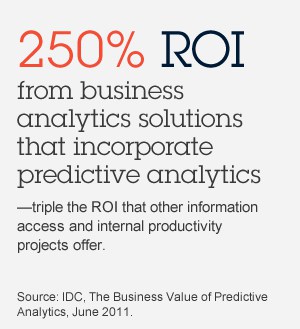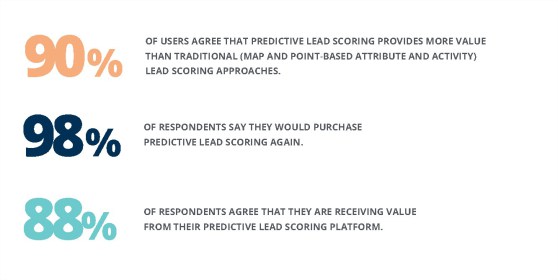Every two days, we generate the equivalent of all the data that existed up to 2003.
It’s an impressive figure. Meanwhile, as the sheer volume of data increases exponentially, the costs of storage and computing power are plummeting. The combination of these monumental events is giving rise to the “Big Data” era—an era in which humans have the ability to tap into vats of data regarding questions and problems that have never been assessed before.
And marketers are chomping at the Big Data bit.
Marketers are beginning to operationalize Big Data to produce more qualified leads, to focus content operations more tightly on target markets, and to predict future behaviors of leads with predictive lead scoring.
What Is Predictive Lead Scoring?
Predictive lead scoring is a data-backed lead scoring methodology that leverages historical data and predictive analytics. But to really understand  predictive lead scoring, let’s first get a solid grasp on traditional lead scoring.
predictive lead scoring, let’s first get a solid grasp on traditional lead scoring.
Unpacking “Lead Scoring”
Lead scoring is the process of attributing various numerical qualifiers to people based on data. Marketers or businesses “rank prospects against a scale that represents the perceived value each lead represents to the organization. The resulting score is used to determine which leads a receiving function (e.g. sales, partners, teleprospecting) will engage, in order of priority.” (view the full Wikipedia page)
There are two different kinds of information that affect a lead score.
- Explicit Data
- Implicit Data
1. Explicit data is based on information the prospect tells you outright, like:
- Company email address
- Business title
- Area of work
2. Implicit data is more implied information, such as:
- Online behavior or engagements with various content
- Blog subscriptions
- Clicking or viewing various content or buttons on your site
In traditional lead scoring, marketers rank the importance of various implicit data actions to understand a buyer’s intent and qualify leads for sales teams. For example, a company may attribute a higher lead score to a visitor who organically finds your homepage and clicks “receive a demo,” than someone who just read a blog post and bounced. Similarly, clicking a link in an email may score higher than simply opening the email.
If leads are scored accurately, marketers can effectively send valuable new leads—and information about their behavior—to sales teams.
Unfortunately, humans make errors.
They often “weigh” various digital behaviors subjectively, intuitively, or based on methods that once worked in the past. Marketers may get caught up in data or digital behaviors that once were correlated with buying intent, but no longer are, thereby sending over-scored and under-qualified leads to sales. Similarly, sales reps may hold similar vestiges of the past; expecting leads to have certain implicit or explicit data tied to them. If their lead is missing a key piece of data, they may pass up that lead (errantly) for a different lead. In both cases, key opportunities can be missed and revenue lost.
Enter: Predictive Lead Scoring
Predictive lead scoring is at the intersection of lead scoring and predictive modeling—and is designed to reduce human error and increase quality of leads.
Predictive modeling is a commonly used statistical technique to predict future behavior. It analyzes historical and current data to generate a model to help predict future outcomes algorithmically with a high level of certainty. The model is validated or revised as additional data becomes available.
Predictive lead scoring takes this approach and puts it into the hands of sales and marketing. Predictive lead scoring analyzes data around successful leads (leads that became closed won). Specifically it pulls internal information from your CRM and marketing automation solutions and adds digital footprints from third-party sources including other Internet sources, to pool as much data as possible around that lead.
By crunching this pool of data, predictive lead scoring presumably:
- Identifies patterns and relationships that may never have been noticed before
- Reduces the margin of human error in traditional lead scoring
- Aids sales/marketing alignment and relationships by providing a data-backed reason for all lead scoring qualifications
Available, But Unrealized
Most organizations are already sitting atop of pile of data that could be mined and analyzed. Things like CRM systems and marketing automation technologies are brimming with digital information about website visitors. However, they’re failing to realize the power in that data.
A whopping 79% of B2B marketers have not established even traditional lead scoring, despite the fact that companies excelling at lead nurturing generate 50% more sales-ready leads at 33% lower cost. This is surprising as the marketer’s role continues to be more accountable for revenue generation.
But new research by SiriusDecisions suggests the adoption of advanced attribution modeling and predictive modeling is increasing. In their report, Predictive Lead Scoring 2014 Study, Sirius found that 64% of B2B organizations surveyed have used predictive lead scoring for less than a year, 24% for one to two years, 5% from two to three years, and 7% have used predictive lead scoring for longer than three years. These stats suggest that as each year passes, more and more companies are adopting the technology.
Unsurprisingly, the technology industry represents the biggest chunk of early adopters. 78% of companies using predictive lead scoring are in the High Tech industry. This could be because technology companies already have a good concept of digital data.
Toby Murdock, CEO of Kapost, says predictive lead scoring is best for companies that have a lot of data to leverage—typically larger, more mature companies.
“The more mature the company, the more impactful predictive lead scoring can be,” Murdock says.
But regardless of the reason, analysts suggest predictive analytics could become more of a staple in sales and marketing efforts.
“For far too many organizations, traditional lead scoring has been much less useful than hoped,” said Jay Famico, Practice Director Technology at SiriusDecisions. “However, predictive lead scoring can be an enormously powerful tool to focus organizations’ revenue-facing functions’ efforts on leads that are likely to convert.”

How to Become a Revenue Marketer
If this article intrigued you, but seemed way over your head, we’ve identified the first few steps and resources to get you started with implementing a revenue-marketing strategy, complete with lead scoring (whether it’s traditional or predictive).
Step 1: Read the Pedowitz Group’s book, Rise of the Revenue Marketer. They are the guys that coined the phrase, and this resource takes an expansive and complete perspective on the modern marketer.
Step 2: Invest in the core marketing technologies for modern marketing at the enterprise level. There are more than 500 marketing technologies, you only really need 5. These are the 5.
Step 3: The above step takes money. Don’t lose your investment. Structure your marketing strategy correctly from the beginning, so that your all of the pieces work in an integrated and seamless way.
VentureBeat Published this Infographic
Streamline Your Marketing Strategy
Want only the essentials of a best-in-class content marketing campaign? Follow these simplified guidelines to create a marketing strategy that works for your brand.



